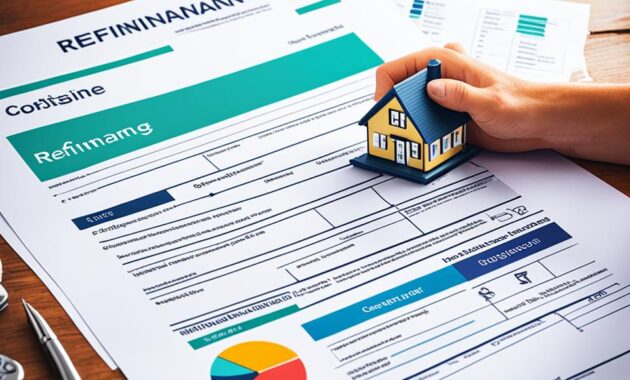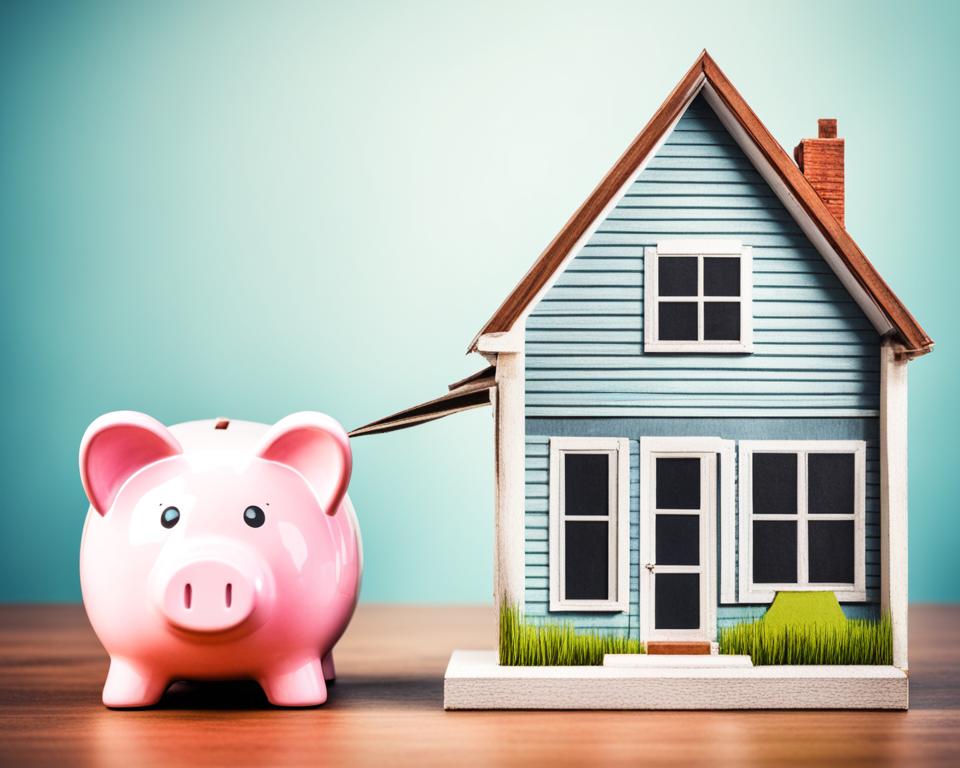In the current mortgage landscape, homeowners are actively seeking strategies to enhance their financial flexibility and savings. Whether your aim is to diminish your monthly payments, tap into your home’s equity, or secure improved loan terms, the realm of home refinancing presents a plethora of opportunities. This guide aims to illuminate the diverse refinancing options, their advantages, and the pivotal factors to ponder as you embark on this financially stimulating journey.
Key Takeaways
- Understand the benefits of home refinancing, including lower monthly payments and access to home equity.
- Explore different refinancing options, such as cash-out refinance, rate-and-term refinance, and debt consolidation.
- Learn about the factors to consider before refinancing, including current mortgage rates and your credit scores.
- Discover how to calculate the costs of home refinancing and find the right lender for your needs.
- Understand the application process and the importance of timing your refinancing decision.
Understanding the Benefits of Home Refinancing
Refinancing your home can be a strategic move that opens up a world of financial possibilities. Homeowners can unlock two key benefits: lower monthly payments and access to home equity through this approach. It’s a method that can significantly enhance your financial situation.
Lower Monthly Payments
Homeowners often refinance to reduce their monthly mortgage payments. This is achieved by securing a lower interest rate, which can significantly impact the overall cost of your loan. When interest rates drop, refinancing allows you to replace your existing mortgage with a new one at a more favorable rate. This can save you hundreds or even thousands of dollars each year.
Access to Home Equity
Another significant benefit of home refinancing is the ability to tap into the equity you’ve built in your home. Home equity is the difference between your home’s current market value and the outstanding balance on your mortgage. By refinancing, you can access this equity through a cash-out refinance. This provides you with funds that can be used for a variety of purposes, such as debt consolidation, home improvements, or even investments.
| Benefit | Description |
|---|---|
| Lower Monthly Payments | Refinancing can help you secure a lower interest rate, reducing your monthly mortgage payments and saving you money over the life of your loan. |
| Access to Home Equity | Refinancing allows you to tap into the equity you’ve built in your home, providing you with funds that can be used for a variety of purposes. |
“Refinancing your home can be a game-changer, offering you the opportunity to save money and unlock the value of your property.”
By understanding the key benefits of home refinancing, homeowners can make informed decisions about whether this financial strategy is the right choice for their personal and financial goals.
Exploring Different Home Refinancing Options
Homeowners have a plethora of refinancing options at their disposal. These range from cash-out refinance to rate-and-term refinance, each tailored to meet distinct financial objectives. It is imperative to comprehend these options thoroughly to select the most suitable one for your circumstances.
Cash-Out Refinance
A cash-out refinance enables homeowners to leverage their home’s equity, converting a segment of it into cash. This strategy is invaluable for consolidating debt, enhancing the property, or addressing other monetary obligations. During a cash-out refinance, the homeowner secures a new mortgage for an amount exceeding the current balance, with the excess provided as a cash payment.
Rate-and-Term Refinance
The rate-and-term refinance is a favored choice, enabling homeowners to refinance their current mortgage for a lower interest rate or varied loan duration. This approach can diminish monthly installments, decrease the loan’s total cost, or abbreviate the repayment duration.
| Home Refinancing Option | Key Features | Potential Benefits |
|---|---|---|
| Cash-Out Refinance |
|
|
| Rate-and-Term Refinance |
|
|
By delving into these refinancing alternatives, homeowners can pinpoint the solution that harmonizes with their fiscal aspirations and requirements. It is crucial to meticulously weigh the advantages and disadvantages of each option to ensure an informed choice.
Cash-Out Refinance: Unlock Your Home’s Equity
A cash-out refinance enables homeowners to access the equity they’ve accumulated in their property. This financial strategy is ideal for those aiming to consolidate debt, fund home enhancements, or fulfill other financial objectives. By utilizing their home’s value, cash-out refinancing enhances financial flexibility and facilitates the acquisition of necessary funds.
Debt Consolidation
One of the key advantages of a cash-out refinance is consolidating outstanding debts, like credit card balances or personal loans, into a single, possibly lower-interest mortgage. This approach simplifies monthly payments and may diminish the total cost of servicing these debts over time.
Home Improvements
Another prevalent application of cash-out refinancing is financing home improvement endeavors. Homeowners can leverage their equity to fund upgrades, such as kitchen renovations, bathroom additions, or energy-efficient enhancements. Such investments can enhance the property’s value and improve its resale potential.
| Benefit | Description |
|---|---|
| Debt Consolidation | Combine multiple debts into a single, potentially lower-interest mortgage payment. |
| Home Improvements | Access funds to finance upgrades, renovations, or energy-efficient projects. |
When contemplating a cash-out refinance, homeowners must meticulously assess their financial circumstances and future aspirations. Evaluating the potential advantages against the costs helps individuals determine if this refinancing strategy aligns with their needs.
Rate-and-Term Refinance: Securing Better Loan Terms
Homeowners aiming to enhance their financial health may consider a rate-and-term refinance. This strategy involves replacing your current mortgage with a new loan, boasting more advantageous loan terms. These can include a diminished interest rate or a condensed repayment duration.
The primary benefits of a rate-and-term refinance are:
- Potentially lower monthly payments through a lower interest rate
- Shorter loan duration, which can lead to substantial interest savings over the mortgage’s life
- Switching from an adjustable-rate mortgage (ARM) to a fixed-rate loan for enhanced stability
Refinancing leverages current market conditions and your enhanced financial position to secure more beneficial loan terms. This approach can yield considerable long-term savings and alleviate mortgage management stress.
“Refinancing can be a wise financial decision, but it’s crucial to meticulously assess the potential advantages and expenses to confirm it matches your objectives.”
For those seeking to diminish monthly payments or expedite mortgage payoff, a rate-and-term rate-and-term refinance is a viable option. It should be evaluated as part of a comprehensive financial strategy.
Factors to Consider Before Home Refinancing
Homeowners must meticulously evaluate several critical factors before deciding on home refinancing. Key elements such as current mortgage rates, personal credit scores, and financial situation are paramount in assessing the viability and potential advantages of refinancing.
Current Mortgage Rates
The primary motivator for refinancing is often the chance to obtain a lower interest rate on your mortgage. Mortgage rates are subject to significant fluctuations over time, necessitating a keen awareness of current market conditions. This knowledge allows homeowners to gauge whether refinancing could lead to substantial monthly payment reductions or a decrease in the loan’s total cost.
Credit Scores and Financial Situation
When contemplating home refinancing, one’s credit scores and financial situation are indispensable considerations. Lenders scrutinize creditworthiness, income, and debt-to-income ratios to ascertain eligibility and offer terms. A robust credit score and a financially stable position enhance the likelihood of securing advantageous refinancing terms.
By meticulously examining these factors, homeowners can make a well-informed decision regarding refinancing’s appropriateness for their financial circumstances and future objectives. A comprehensive understanding of the potential benefits and drawbacks underpins a successful refinancing endeavor.
“Refinancing your home can be a strategic move, but it’s crucial to weigh all the factors carefully to ensure it’s the best decision for your financial well-being.”
Calculating the Costs of Home Refinancing
Refinancing your home can be a strategic financial move, but understanding the home refinancing costs, closing costs, and fees is crucial. By meticulously calculating these expenses, you can ascertain whether refinancing suits your financial objectives.
One of the main expenses tied to home refinancing is the closing costs. These typically account for 2% to 5% of the loan’s total and encompass various fees such as appraisal, origination, title insurance, and administrative charges. It is imperative to obtain a comprehensive breakdown of these costs from your lender to grasp the financial implications fully.
| Cost Type | Average Range |
|---|---|
| Appraisal Fee | $300 – $500 |
| Origination Fee | 0.5% – 1% of loan amount |
| Title Insurance | 0.5% – 1% of loan amount |
| Other Fees | Varies |
Moreover, refinancing may involve additional fees, such as prepayment penalties on your current mortgage or a loan application fee. These costs can escalate swiftly, necessitating their inclusion in your overall cost assessment.
To gauge the viability of refinancing, juxtapose the potential savings from a reduced interest rate or altered loan terms against the home refinancing costs. This comparison facilitates an informed decision, ensuring it resonates with your financial priorities and long-term aspirations.
Finding the Right Lender for Your Home Refinancing Needs
Choosing the right lender is a pivotal step in the home refinancing process. You have two primary options: online lenders and traditional banks. Understanding the differences between these two can aid in making an informed decision, securing the best deal for your financial needs.
Online Lenders vs. Traditional Banks
Online lenders have gained popularity for their convenience and often lower rates. They operate entirely online, simplifying the application and approval process. This can result in a quicker turnaround time and more flexible eligibility requirements compared to traditional banks.
Traditional banks, on the other hand, boast a long-standing reputation and may offer a more personalized experience. They provide face-to-face interactions, which some borrowers prefer, and have a deeper understanding of local real estate markets. However, their loan approval process can be more stringent and slower.
Comparing Loan Offers
When comparing loan offers from home refinancing lenders, it’s crucial to consider several factors:
- Interest rates: Compare the annual percentage rates (APRs) offered by different online lenders and banks to find the most competitive rate.
- Loan terms: Evaluate the loan repayment periods, such as 15-year or 30-year mortgages, to determine the best fit for your financial goals.
- Fees and closing costs: Look out for application fees, origination fees, and other charges that can add up and affect the overall cost of refinancing.
- Customer service: Consider the lender’s responsiveness and the level of support they provide throughout the comparing loan offers process.
By meticulously evaluating and comparing loan offers from various home refinancing lenders, you can make an informed decision and secure the best deal for your home refinancing needs.
Home Refinancing: A Smart Move for Financial Flexibility
Home refinancing is a pivotal strategy for enhancing financial management. It leverages the equity in your home, offering a pathway to financial flexibility. This flexibility is essential for achieving financial objectives, such as debt consolidation, home improvements, or augmenting home refinancing benefits.
One of the core benefits of home refinancing is the potential to reduce monthly mortgage payments. By securing a lower interest rate or extending the loan term, homeowners can liberate funds for other financial priorities. This is particularly advantageous for those aiming to consolidate high-interest debts, like credit cards or personal loans, into a single, more manageable payment.
A cash-out refinance enables homeowners to access the equity they’ve accumulated, providing funds for diverse purposes. Whether for enhancing your property’s value or establishing a financial reserve, this option can be a prudent choice.
“Refinancing your home can be a powerful tool for improving your overall financial flexibility and achieving your long-term goals.”
However, it’s crucial to weigh the costs and potential risks of home refinancing before deciding. Yet, for many homeowners, the advantages of enhanced financial flexibility and improved financial management make it a worthwhile consideration.
The Application Process: What to Expect

Embarking on the journey of home refinancing may appear formidable, yet a comprehensive grasp of the home refinancing application process equips homeowners with the necessary tools for a streamlined experience. This discourse aims to elucidate the essential steps, from the compilation of documents to the anticipation of the approval timeline, facilitating a clearer understanding of the refinancing pathway.
The initial phase of the refinancing application necessitates the accumulation of requisite documentation. This ensemble typically encompasses:
- Your most recent mortgage statement
- Proof of income, such as pay stubs or tax returns
- Proof of homeownership, such as a deed or title
- Information about your current home value, which can be obtained through an appraisal or recent comparable sales in your area
Post-document compilation, the application process commences with your selected lender. This entails the submission of your application, the provision of any supplementary information or documentation, and a credit check.
The approval timeline for home refinance varies significantly, contingent upon the lender’s policies and the intricacies of your financial profile. Generally, the process spans from 30 to 60 days, with some entities capable of expedited approval within two weeks. Concurrently, your lender will scrutinize your application, conduct a home appraisal, and render a definitive verdict on your refinancing eligibility.
Comprehending the home refinancing application process equips you with the acumen to navigate the refinancing odyssey with aplomb, ensuring a more efficacious and less arduous experience. The cornerstone of a triumphant refinance lies in meticulous organization, patience, and a collaborative approach with your lender throughout the process.
Timing Your Home Refinancing Decision
The decision to refinance your home necessitates a meticulous approach. It’s vital to evaluate the timing meticulously to achieve the most favorable outcome. Key considerations include the prevailing market conditions and your personal financial objectives.
Market Conditions
Mortgage rates exhibit considerable volatility, necessitating vigilant monitoring. In a low-rate environment, refinancing could lead to reduced monthly payments or improved loan terms. Conversely, a rising rate scenario might prompt swift action to avoid higher costs.
Personal Financial Goals
Your financial situation and goals significantly influence the timing of refinancing. Perhaps you aim to access funds for renovations, consolidate debt, or cover unforeseen expenses. Alternatively, you might seek to expedite loan repayment. Clarifying these objectives will pinpoint the most strategic refinancing approach and timeline.







